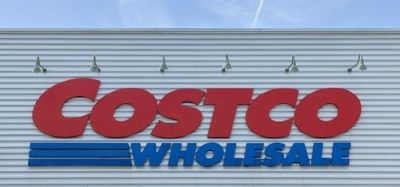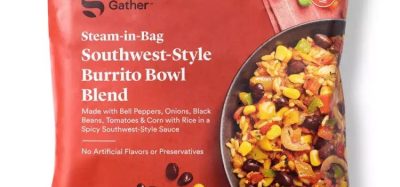The future of food safety starts with hygienic design
Posted: 12 May 2010 | Joe Stout, Consultant (formerly Director of Product Protection & Hygienic Design, Kraft Foods) | No comments yet
In the media recently, we have heard a barrage of information that is most certainly bad news. We hear about earthquakes, national debt, war, real estate foreclosures and unfortunately, it seems that there is always some news about food safety recalls associated with allergens or pathogens which have sickened or caused fatalities to consumers. These consumers happened to purchase ingredients or finished products and while not suspecting the onset of an illness, ate something which made them ill. This was not the expectation of many or any consumer. In fact, the number one expectation of consumers, customers, regulatory groups and the food industry is that RTE food available for purchase is safe to prepare and serve to families and friends.
In the media recently, we have heard a barrage of information that is most certainly bad news. We hear about earthquakes, national debt, war, real estate foreclosures and unfortunately, it seems that there is always some news about food safety recalls associated with allergens or pathogens which have sickened or caused fatalities to consumers. These consumers happened to purchase ingredients or finished products and while not suspecting the onset of an illness, ate something which made them ill. This was not the expectation of many or any consumer. In fact, the number one expectation of consumers, customers, regulatory groups and the food industry is that RTE food available for purchase is safe to prepare and serve to families and friends.
In the media recently, we have heard a barrage of information that is most certainly bad news. We hear about earthquakes, national debt, war, real estate foreclosures and unfortunately, it seems that there is always some news about food safety recalls associated with allergens or pathogens which have sickened or caused fatalities to consumers. These consumers happened to purchase ingredients or finished products and while not suspecting the onset of an illness, ate something which made them ill. This was not the expectation of many or any consumer. In fact, the number one expectation of consumers, customers, regulatory groups and the food industry is that RTE food available for purchase is safe to prepare and serve to families and friends.
Why so many issues with food recently? Some offer suggestions that diagnostic technology and communication of and reporting illnesses are now more sophisticated than ever and in fact, there is truth to this. The testing methods for allergens and pathogens are more sensitive, accurate and provide results faster than even a few years ago. The networks which collect epidemiological data from hospitals, doctors and health agencies can categorise it and pinpoint clusters of illnesses and identify the potential sources. We are realising that illnesses which may have been previously identified as isolated incidents, are being connected and can lead investigators to find the source, which could be a single source from a field, farm, processing plant or even a retail store. In the past, this may not have brought sufficient information to result in a recall, but with today’s science, data and efficient communication we have the opportunity to take questionable products from the shelves. This leads to negative news in the media, but ultimately this helps reduce failures in the food chain as contamination points or sources can be indentified and eliminated.
If you are reading this article, you are most likely a member of the food industry family. As such, you and your company could be impacted by a food safety recall generated within your company, or from outside (from another company). In the case of the latter, without cause or justification, your company, although not the source of the recall, could lose sales and customer support. In most cases, a consumer doesn’t intentionally target any processor in the same category, however, the perspective of the meal preparer is that they are responsible for preparing and feeding their families safe food without risks of illness. If there is a recall for peanuts from one processor, there could be an impact for all processors who sell any product which may contain peanuts or even peanut butter. As an example, in the United States after the Peanut Corporation of America (PCA) recall for salmonella in peanut paste, there were declines in peanut butter and roasted peanut sales from processors. The consumer for the most part stayed away from peanut containing items and in essence stopped buying a segment of the industry even though most producers were not involved in the recall. Likewise, when there was a spinach recall in the United States in 2007, there was a corresponding decrease in the sales of salad dressings. Who would have predicted this linkage – even though it seems obvious now? It is very important to note as shown by these two examples that each recall event could have an unintended impact on other products in the marketplace. Furthermore, it does have a tendency to cause consumers to lose confidence in the food supply.
What does this have to do with sanitary design? It is an indication that we, ‘the food industry family’, are in this together and must work together where possible to reduce risk to the consumer and associated recalls for food safety. This brings us to a focused effort to improve sanitary design.
It starts with sanitation
Before we begin a discussion on Hygienic (sanitary) Design, it is important to spend time mentioning sanitation (cleaning) effectiveness. This is the first and most important step to protect the safety of food for consumers. Good sanitation is the foundation of life and without it there would be illness, sickness and the spread of disease. Sanitation should be what we focus on before we start the production line, rather than what we do when the line shuts down at the end of the shift. I have worked in sanitation for most of my career and have learned (in some cases the hard way) to respect the importance of effective sanitation. I continue to learn when I visit a facility to observe cleaning. It always amazes me to see how much effort, dedication, passion and hard work it takes to clean a food plant – or any single piece of equipment. What is more amazing is the individuals who do the cleaning are dedicated to do it right, care about the consumer and have passion for perfection. They are the folks on the front line of food safety and routinely execute the cleaning programs and pre-operational inspections to have a successful start-up on the way to a successful production run.
During my career, I have worked in many segments (dairy, meat, beverage, snacks and baked goods) of the food industry and I marvel at the improvements which have been made in sanitation and sanitary design in some of these segments. At the same time, there are other areas where significant equipment development is still needed. The sanitation and sanitary design improvements made in the industry regardless of the segment all seem to yield the same end state: a more effective and efficient sanitation process which allows equipment to be cleaned effectively (making safer food) and more efficiently (reduced time, labour and chemicals). Ultimately, this is a perfect business case for insisting that equipment and facilities are designed to be effectively and efficiently cleaned.
A disciplined process for sanitation
Safe food production starts with sanitation excellence, and conversely, if the sanitation is completed incorrectly, the first hour, day or week could cause your product to be a risk to your quality or food safety. The best option is to assure that sanitation is completed right the first time and routinely every time. Therefore, this process must be managed and executed in a disciplined way. One of the approaches used in the industry is the ‘seven step’ cleaning process which provides step by step guidance on a consistent way to clean in the correct sequence. If this method is followed, there will not be cross contamination which could occur if we removed soil from one piece of equipment and deposited it on another piece or an adjacent line. The goal is to remove soil and then direct it to a drain or vessel designed to catch or hold that material. The worst case scenario is for a piece of equipment (just cleaned) to be soiled as a person is cleaning another piece of equipment or a part of the infrastructure such as the floors or walls. This one of the major benefits of the seven step cleaning process, as cleaning is sequenced so we will not soil what has already been cleaned.
The genesis of an idea starts like a seed and grows, and in this case, I observed an individual cleaning a meat conveyor below a mezzanine. He achieved the state of perfect cleanliness and shortly thereafter, a person on the mezzanine proceeded to ruin his day and work product with a stream of water from a hose that pushed soil, water and unclean materials on the previously cleaned conveyor. What destruction of perfection!! Not to be distressed – a process was soon to be developed that enhanced the cleaning process by placing critical steps in the correct sequence. I love clean and this process helps get us there! When followed, this cleaning process helps drive effectiveness and efficiency to the sanitation process. Figure 1 takes a holistic view of cleaning and places critical tasks in the correct sequence. Tasks such as cleaning floor drains need to be in the right order so you would not cause potential contamination of clean equipment as the task is completed. Also another critical point is when the persons doing the cleaning actually change clothing to transition from working in a raw to a RTE environment.
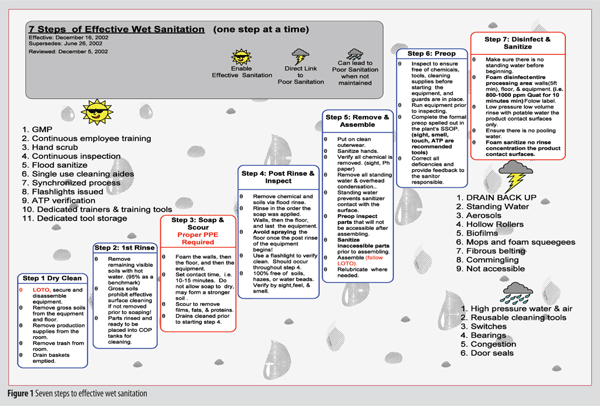

In the detailed process in Table 1, you can see the seven step process identified. The way this process is documented, the seven steps are on the left with the details of the subtasks of each step. To the right you can see the numbers 1, 2 & 3. These numbers represent three persons who clean the line and the steps they are responsible for. They can be easily assigned and can visualise what they need to get accomplished and in what time frame. The vertical columns represent a time period, in this case it is 30 minutes. Our goal is to accelerate the cleaning time to give us the opportunity to make product rather than clean.
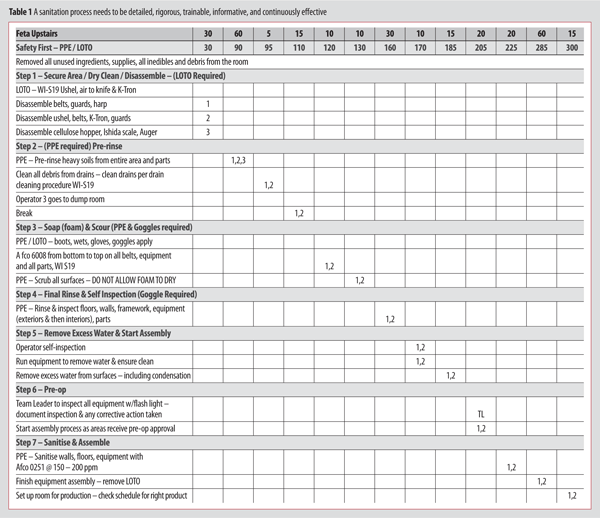

Navigating design standards
Here you are at a stage where you are going to procure a new process with new equipment. How exciting and what a great opportunity for your food business and the manufacturing location. Okay, what to do first? Based on the sanitation and cost needs mentioned, we clearly want a new process that takes us into the future to assure that our processes are effective and efficient. Well said. So, how do we get want we need and want? Which standard should we use? How can we select a supplier? Many of the models out there highlight that their equipment meets these standards and are certified – will that get us what we need? Well!!!
Sanitary standards should be reviewed for their validity, applicability, necessity and cost impact but most importantly should be applied using a HACCP based approach, based on the risks associated with your process. A line producing sliced turkey will have a different need than a line making soluble coffee. While most processors would agree a minimum standard should be met by all equipment suppliers, they typically comment on the wide range of applications and custom engineering required and the challenge to apply a single standard equally to all equipment. Also at concern are potential added costs incurred by suppliers and lack of clear mandates from all processors for such design upgrades. The challenge faced by both processors and equipment suppliers are the continually evolving expectations for quality and food safety which starts with the right design. As we know, to have any standard certified by the approving body, it runs the risk of being outdated.
From a design perspective, Figure 2 shows design variation needed based on the robustness of the product and formula. You can see that with a less robust formula than shown, the controls such as equipment and facility design, and manufacturing practices would need to be much more stringent.
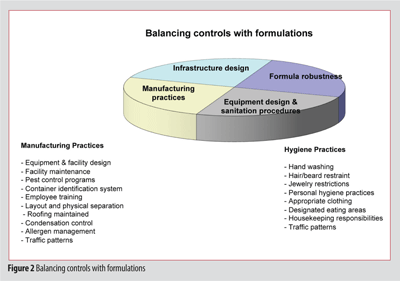

From a process perspective, the best approach is to follow a base design standard relative to your business and then establish a dialogue between the equipment suppliers and the processor. In 2001, the American Meat Institute created the ‘Ten Principles of Equipment Design’. I had the pleasure of leading this group and the principle and check list process brought a cross functional approach to processors (in this case the buyers). Actively involved were; procurement, production, engineering, sanitation, quality and personal safety, with equipment vendors and outside parties to discuss concept and design requirements. Most recently, this same approach is being used with low moisture products with a team I also have the privilege of leading for the Grocery Manufacturing Association (GMA). The GMA list is a modification of the AMI principles with a focus on the different risks with low moisture foods.
The common threads between the 10 principles of the AMI list and the GMA list guiding principles of sanitary design for equipment are:
- Cleanability
- Compatible materials
- Accessibility for inspection, maintenance, cleaning and sanitation
- No liquid collection points
- Hollow areas eliminated or sealed
- No niches
- Sanitary operational performance
- Validation of cleaning and sanitising protocols
- Separate processes wherever possible
- Meet personnel hygiene and sanitation requirements
To support evolution in design, GMA and AMI groups have been actively working with processors and suppliers to communicate the 10 principles and the corresponding checklist that is intended to be used as a calibration and continuous improvement tool for the industry.
In summary, Hygienic Design is critical to allow for the cleanability of equipment to assure that we can routinely produce high quality and safe products. This is directly linked to how we design and execute sanitation programs and understanding a process that cleans equipment and the facility to the level needed for a specific product.





